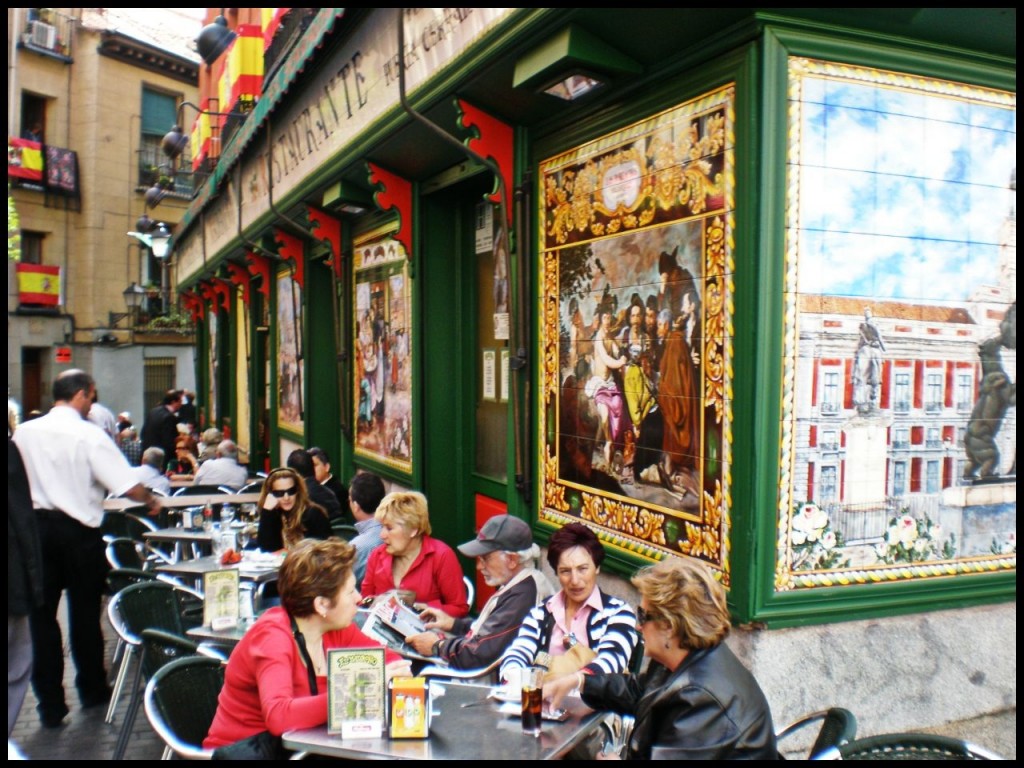 Grab your coffee and enjoy the perspective of Melibee’s own Maria Snyder, today’s guest author. Maria’s experience living in Spain provides a unique lens to the subject of coffee, culture and how we teach it to students. She raises an excellent question – do we push for global education or provide surface learning about culture?
Grab your coffee and enjoy the perspective of Melibee’s own Maria Snyder, today’s guest author. Maria’s experience living in Spain provides a unique lens to the subject of coffee, culture and how we teach it to students. She raises an excellent question – do we push for global education or provide surface learning about culture?
Even during a brief visit anyone can see that the café and bar culture is a big part of Spanish life. People tend to meet not at each others homes instead having a drink or a bite to eat out. Having lived in Spain for ten years I have picked up on changes in habits and values, including this cafe culture. Despite falling in love at first sip with Spanish coffee, my initial visits to the cafes and bars were problematic. They were inevitably filled with thick clouds of cigarette smoke. It was a culture shock no doubt and defined part of my experience of Spain at the time. Then, bit by bit, new laws started changing things. First came smoking and nonsmoking sections, until finally the government put a flat out ban in place. Now it’s like being in a completely different place with all the smokers sitting outside or having a drink by the door. Another change to the café culture has been the slow introduction, in my small town at least, of to-go coffee. Although Starbucks has firmly implanted itself in Madrid and Barcelona in recent years they have yet to come to smaller cities. Here you still see baristas and bartenders walking down the sidewalk, carrying a hot ceramic mug of coffee to their clients working in a local shop and the cafe tables regularly fill mid-morning, but more and more I have noticed a few cafés selling paper cups of coffee.
These are little details, of course, but they demonstrate that “culture” constantly changes and is not uniform across a country. It is neither monolithic nor static. And, although these changes seem superficial, they do show transformations around values relating to health, time, and sustainability. Of course, most people would probably agree that culture changes over time and is hard to pin down. But does this nebulous nature really get explored adequately? Do we consistently challenge static views of culture in international education?
It is easy to neglect such changes when teaching people about other cultures, instead focusing on general information that focuses on a one dimensional view of other ways of living. One way to address this deficiency is to jump from international education to global education. Global education and international education are not synonymous. International education focuses on learning about an area of the world (its people, history, languages, culture) while global education explores issues and concepts than affect people throughout the world and focusing more on the power structures that are forging them. International education is fascinating, it is most accessible to people and fun (imagine the typical country “fair” with a table of food and a flag from different places around the world), while often providing a crucial first step for global education. But it is often, for the most part, too reserved.
 If you want to challenge students’ concepts of static culture and to inspire them to break away from what Dr. Anthony Ogden calls the “colonial student” experience where they observe other peoples as if they were archaeologists, look to global education as the means. It is inherently political, searching for the root of imbalances in power and aiming to increase justice by actively attacking inequalities. The educator becomes an activist. The goal is for students to move beyond a static, pretty view of culture and get a bit dirty, analyzing issues to find interconnectedness across country boundaries and to really dig in and move beyond passive study. Educators can look closely at why changes in culture are happening and what they mean, and link them to global trends. Returning to one of the examples above, we could tell students that Spanish has a vibrant cafe culture and they should go take part and believe that we have given them sufficient information to “know” Spain. Or we can get deeper into the subject and really look at how this culture changes over time, who is affecting the changes, and how a smoking ban has ripple effects in the tobacco industry and government tax income, how it affects citizens’ health and free choice, and consider the possibilities or lack thereof for such a ban in other countries. Or, in the case of to-go coffee, students can look at the environmental consequences of such new trends both in and out of Spain.
If you want to challenge students’ concepts of static culture and to inspire them to break away from what Dr. Anthony Ogden calls the “colonial student” experience where they observe other peoples as if they were archaeologists, look to global education as the means. It is inherently political, searching for the root of imbalances in power and aiming to increase justice by actively attacking inequalities. The educator becomes an activist. The goal is for students to move beyond a static, pretty view of culture and get a bit dirty, analyzing issues to find interconnectedness across country boundaries and to really dig in and move beyond passive study. Educators can look closely at why changes in culture are happening and what they mean, and link them to global trends. Returning to one of the examples above, we could tell students that Spanish has a vibrant cafe culture and they should go take part and believe that we have given them sufficient information to “know” Spain. Or we can get deeper into the subject and really look at how this culture changes over time, who is affecting the changes, and how a smoking ban has ripple effects in the tobacco industry and government tax income, how it affects citizens’ health and free choice, and consider the possibilities or lack thereof for such a ban in other countries. Or, in the case of to-go coffee, students can look at the environmental consequences of such new trends both in and out of Spain.
In other words, there is an opportunity to look at changes in culture on a local level and connect them to world wide issues, giving special attention to who causes the changes and if they are democratic. Looking at cultural change through the lens of global education can introduce students and citizens to the next step of taking action for a more just world.
Interested in further learning on this topic? Here is a brief list of global education resources for educators:
- Teach Unicef https://teachunicef.org/ Detailed lesson plans from UNICEF
- Global Dimension https://globaldimension.org.uk Case studies and lesson plans for use in the classroom
- Oxfam Education https://www.oxfam.org.uk/education/ Resources for teachers
- Global Issues https://www.globalissues.org/ Data and articles showing interconnectedness of issues. Easy to get addicted to this one!
- Peace One Day www.peaceoneday.org “inspire young people to become the driving force behind the vision of a united and sustainable world by advancing active learning in the areas of conflict resolution, global citizenship and human rights”
 About the Author: Maria Snyder is an English teacher in Spain and a strong believer in the power of international exchange. She adores the Spanish language and writes her own blog too. She is an Elderbee in the Melibee hive too!
About the Author: Maria Snyder is an English teacher in Spain and a strong believer in the power of international exchange. She adores the Spanish language and writes her own blog too. She is an Elderbee in the Melibee hive too!


Wonderful points you raise and a great, important highlight at the difference between international and global education.
Makes me nostalgic for the café life of Paris too 🙂
Thanks, Kyle! I wonder how café life has changed there in recent years…